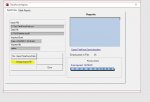Ryobi
Registered User.
- Local time
- Today, 01:38
- Joined
- Mar 5, 2012
- Messages
- 49
Hello everybody,
Does anybody know how to append data from excel CSV into an existing Msaccess table ?
The vba code I had DoCmd.TransferText acImportDelim, , "InputForm8596Form8597", [Forms]![frmTimeForceReports]![Txtimportfile]
used to work, but I am getting error on the data because the software developer from the csv change the out format of the fields (they all used to be text).
I can manually import the data using the append method, but I do want the to have to be appending it every time. I need put the "" as quailfier (see photo attached) something like this DoCmd.TransferText acImportDelim, "" , "InputForm8596Form8597", [Forms]![frmTimeForceReports]![Txtimportfile] which does work. I was thinking of using the insert sql statement but how to I tell it get the data from the excel file ? I was hoping for something like this DoCmd.Inserintotable acImportDelim, "" , "InputForm8596Form8597", [Forms]![frmTimeForceReports]![Txtimportfile] . Any ideas ?
Thanks
Does anybody know how to append data from excel CSV into an existing Msaccess table ?
The vba code I had DoCmd.TransferText acImportDelim, , "InputForm8596Form8597", [Forms]![frmTimeForceReports]![Txtimportfile]
used to work, but I am getting error on the data because the software developer from the csv change the out format of the fields (they all used to be text).
I can manually import the data using the append method, but I do want the to have to be appending it every time. I need put the "" as quailfier (see photo attached) something like this DoCmd.TransferText acImportDelim, "" , "InputForm8596Form8597", [Forms]![frmTimeForceReports]![Txtimportfile] which does work. I was thinking of using the insert sql statement but how to I tell it get the data from the excel file ? I was hoping for something like this DoCmd.Inserintotable acImportDelim, "" , "InputForm8596Form8597", [Forms]![frmTimeForceReports]![Txtimportfile] . Any ideas ?
Thanks

Attachments
Last edited:




